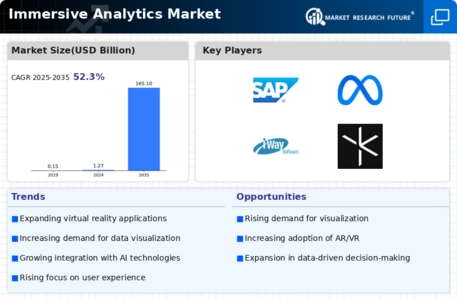Leading market players are investing heavily in research and development in order to expand their product lines, which will help the Immersive analytics market, grow even more. Market participants are also undertaking a variety of strategic activities to expand their footprint, with important market developments including new product launches, contractual agreements, mergers and acquisitions, higher investments, and collaboration with other organizations. To expand and survive in a more competitive and rising market climate, immersive analytics industry must offer cost-effective items.
Manufacturing locally to minimize operational costs is one of the key business tactics used by manufacturers in the immersive analytics industry to benefit clients and increase the market sector. In recent years, the immersive analytics industry has offered some of the most significant advantages to medicine. Major players in the immersive analytics market, including Microsoft Corporation, IBM Corporation, Accenture PLC, Google LLC (Alphabet Inc.), SAP SE, Meta Platforms, Inc., HTC Corporation, HP, Inc., Tibco Software, Inc. (Vista Equity Partners), Magic Leap, Inc. and others, are attempting to increase market demand by investing in research and development operations.
Enterprise application software and related services are offered by SAP SE, also referred to as SAP. Enterprise resource planning, intelligent technologies, financial management, analytics, people engagement, human resources, digital supply chain, spend management, network, customer relationship management, and customer experience are just a few of the many solutions the company provides. SAP focuses in providing enterprise applications and commercial software designed for analytics, mobile platforms, cloud computing, database management, and technology operations.
Energy and utilities, consumer goods, financial services, transportation and logistics, aerospace and defense, chemicals, healthcare, retail, government, higher education and research, real estate, media, and telecommunications are just a few of the numerous industries represented by its customers. With business activities throughout the Middle East, Africa, Europe, the Americas, and the Asia-Pacific area, SAP maintains a presence. Its headquarters are in Baden-Wurttemberg, Germany.
One of the most well-known professional services companies in the world, Accenture is renowned for its dedication to supporting top corporations, governments, and other organizations in strengthening their digital infrastructure, accelerating revenue development, streamlining operations, and improving public services. The company's operations are firmly focused on producing significant, measurable benefits on a broad scale. Accenture is well-known for its extraordinary talent pool and creative approach. With a workforce of 732,000 people serving clients in more than 120 countries, Accenture is a leader.
Accenture uses its large ecosystem of contacts to drive revolutionary change in the fast changing technological landscape of today. The unique value proposition of the company combines technological know-how with unrivalled industry knowledge, specialized capabilities, and a capacity for worldwide delivery. Accenture's track record of achieving real-world results, made possible by its wide array of services, solutions, and assets across Strategy & Consulting, Operations, Technology, Industry X, and Accenture Song, further solidifies the company's reputation.








Leave a Comment